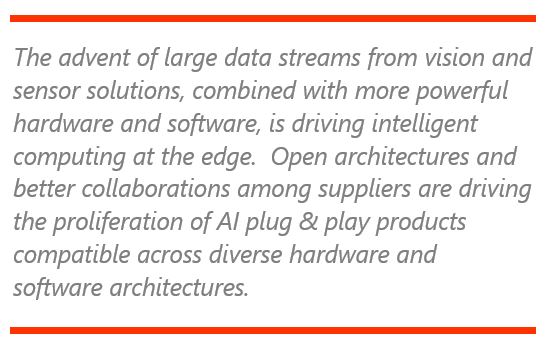

Embedded systems are becoming more important for applications in the operational 
The ongoing success of the exhibition is due mainly to the growing popularity of embedded systems, especially in the retail, automotive and medical sectors. Just as the importance of software is rising, the use of embedded systems (the combination of dedicated computer hardware and software designed for a specific task within a larger system) is also growing rapidly. An example is the growing use of embedded systems in machine vision applications.
Industrial PC suppliers have exhibited at Embedded World for many years as many of them like Kontron, iEi and Advantech offer systems on modules (SoM) and other embedded solutions. Relatively new exhibitors at the show are IT companies like AWS and Microsoft, while automation suppliers like Siemens, Beckhoff, Harting, and Phoenix Contact are growing their footprint in the embedded market. Evidence of this activity is Beckhoff’s announcement of its acquisition of ADL Embedded Solutions during the exhibition.
Kontron announced some new products at the show, including the KBox A-330-RPI DIN-rail mounted industrial PC based on a Raspberry Pi module. Several years ago, ARC predicted that the Raspberry Pi will evolve from a hobby device into a basis for industrial components. This trend was evident this year with similar announcements by companies like JanzTec, Kunbus, and even some large IPC suppliers.
Siemens was present with a booth to promote solutions of Mentor, which it acquired in 2017. These solutions allow users to take advantage of the latest multicore and heterogeneous SoCs to build reliable, secure systems. According to the company these systems offer rich graphics and connectivity using Mentor's customizable embedded Linux solution, the energy-efficient Nucleus real-time operating system, and a Type 1 hypervisor. Mentor also announced a partnership with Advantech and AMD to make AI technologies more accessible and easier to implement, and thus create more AI-based business opportunities.
Other hot topics discussed in recent years in the embedded and automation worlds are Open Source and OPC UA over TSN. For industrial networks, the OPC Foundation’s PubSub protocol is set to become the communication standard for field devices with the potential to replace existing fieldbuses. Many believe that time-sensitive networking (TSN), a widely accepted timing mechanism that has been incorporated into the IEEE Ethernet standard, makes existing “open-proprietary” timing mechanisms superfluous.
The Open Source Automation Development Lab (OSADL) plans to provide an industry-compatible open source solution for OPC UA PubSub with TSN. In phase 1 of the project, OSADL developed a brokerless OPC UA PubSub over IP multicast and binary message encoding format. The publisher was integrated into a regular OPC UA server with additional real-time interrupting and the subscribers were implemented as standalone software. Heidelberger Druckmaschinen, Kontron, Linutronix, Pilz, and Sick all participated in this effort.
The second phase of the project was launched at Embedded World. OSADL plans to complete the open source implementation of OPC UA PubSub in its functional scope and make it stable and certifiable. In addition, the second project phase should enable the use of OPC UA via TSN in real products. When finished, everything will be made available to the industrial automation market. On the software side, a configuration of TSN endpoints, a generic interface to TSN and a security layer are to be developed to improve the real-time capability of OPC UA.
ARC Advisory Group clients can view the complete report at ARC Client Portal
If you would like to buy this report or obtain information about how to become a client, please Contact Us
Keywords: Embedded systems, AI, ML, IPC, Edge devices, IIoT, Embedded world, ARC Advisory Group.

